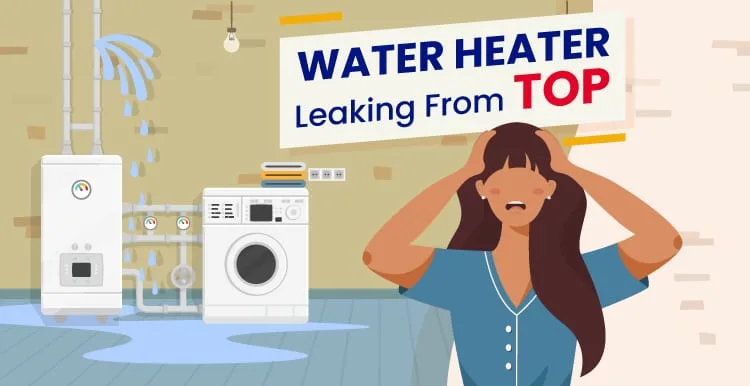Are you searching for a solution to a “water heater leaking from top?”
If so, you came to the right place. Our complete guide covers common causes, quick fixes, and when to call a pro.
Read on to learn more.
We partnered with Networx to help you find local plumbers in your area. Click to below to get a FREE quote.
Water Heater Leaking From The Top?
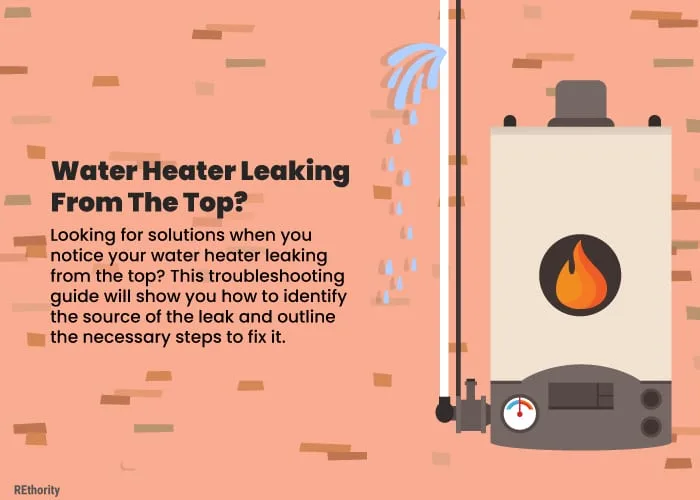
Looking for solutions when you notice your water heater leaking from the top?
This troubleshooting guide will show you how to identify the source of the leak and outline the necessary steps to fix it.
Some water heater issues will require a licensed plumber to fix them. Fortunately, if you find your water heater is leaking from the top parts or fittings, it’s usually a problem that can easily be fixed by a professional.
Or by you, if you’re handy and have some experience with plumbing. A water heater leaking from the top rarely needs to be replaced, as long as it’s not more than 10-13 years old.
Water Heater Leaking From Top vs Bottom
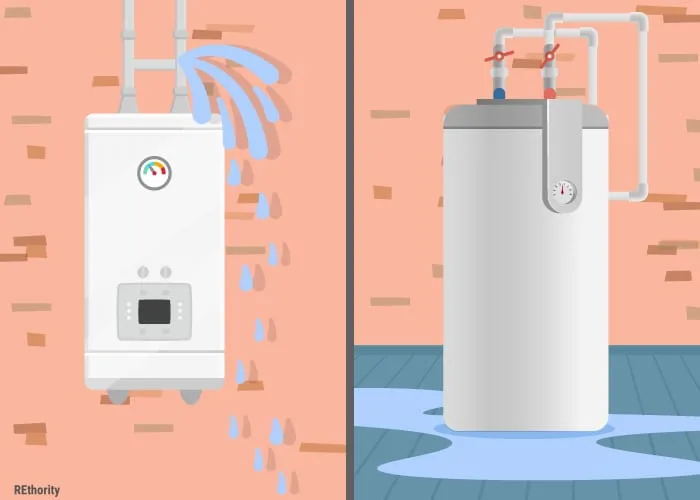
Although a leak from the top is a better scenario than it leaking from the bottom, the flow of water onto electrical parts can still cause severe damage to your water heater.
A persistent leak can cause water damage to your home if you don’t take action right away. You may be able to avoid buying a new water heater by first checking a few things.
Can it be fixed with an inexpensive new part or a simple adjustment?
Maybe. Let’s start by outlining the most common issues behind a water heater leaking from the top instead of the bottom.
Water Heater Leaking from Top: Find the Source of the Leak
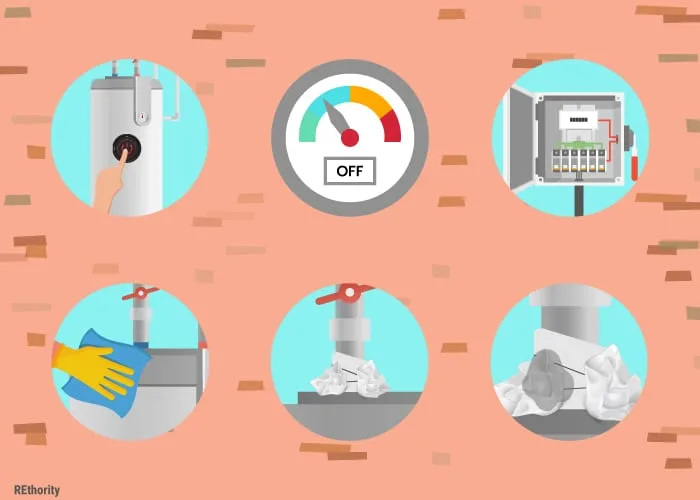
Before you go any further, the first thing you should do is turn off the power to your water heater.
There are electrical components inside and a risk of shock if you don’t ensure there is no power to the water heater before you inspect it to find the source of the leak.
- If you have a gas water heater, just turn the thermostat control knob to the OFF position.
- If you have an electric water heater, flip the corresponding circuit breaker switch on your electrical panel to the OFF position.
For now, leave the cold water inlet alone. This way, you’ll have the flow of water to help you locate the leak. Dry the top of the water heater where the cold water inlet meets the tank.
See if you still notice water leaking from the top after drying the water. If that doesn’t seem to be the source, run your hand along the pipes and fittings to see if you can feel where the leak is coming from.
You can also try wrapping the pipes in tissue paper and watching for moisture to find the leak. Keep a careful watch on the tissue paper to see where water appears first.
Ball Valve

You’ll See: Water pooled on top of your water heater, water dripping from the ball valve lever.
If you notice pooled water on top of your water heater, the problem could be with either the cold water inlet pipe or the ball valve. The ball valve (aka gate valve) controls the water heater’s flow of water.
If the lever is parallel with the cold water inlet pipe, the valve is open, and water can flow into the tank. If the lever is at a right angle to the pipe, the valve is closed and not allowing water to flow into the tank.
If you see water dripping from the lever itself or the ball valve, carefully tighten the nut that secures the lever. Do not over-tighten the nut. If the leak continues, keep looking for the source.
You might notice that the leak gets worse when you tighten the nut. If so, you will need to replace the ball valve. Call a plumber to take care of this problem quickly to avoid water damage.
Temperature and Pressure Relief Valve
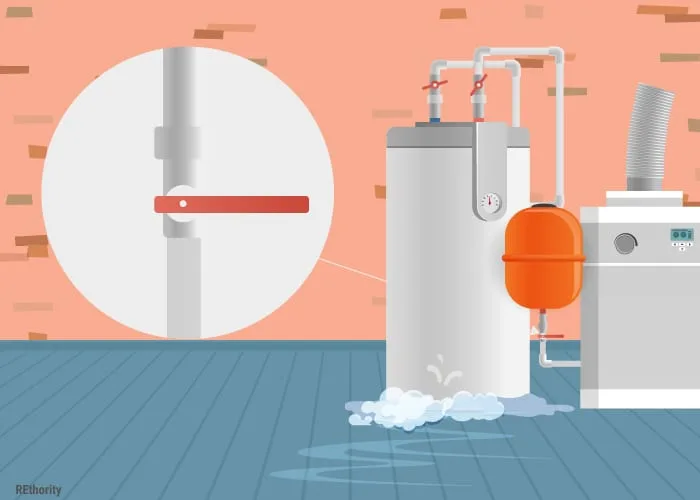
You’ll See: Water leaking from and around the TPR valve on the top-center of the tank.
The temperature and pressure relief valve (TPR valve) is located at the top of your water heater in the center. It serves an essential purpose.
When the temperature or pressure inside the water heater rises to dangerous levels, this valve opens to release excessive pressure. This prevents the water heater from exploding or being damaged by the pressure.
If you can see that the TPR valve is leaking, you should call a plumber to replace the valve. Once they’ve replaced the valve with a new one, your leak should be gone.
Expansion Tank
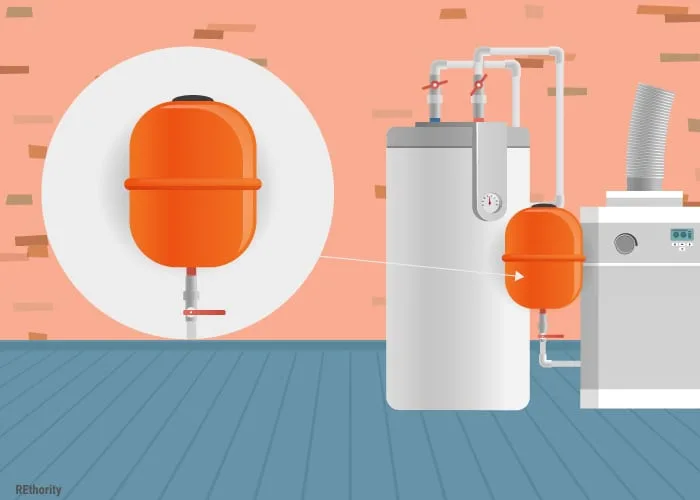
You’ll See: Water dripping from the top of the expansion tank or the tank’s body.
Your water heater may have an expansion tank that allows it to release excess water and pressure created when the water inside the water heater heats up.
If you see a small, roughly basketball-sized tank mounted near your water heater, that’s the expansion tank. Expansion tanks do wear out over time and need to be replaced every 5-10 years.
Inspect it carefully to see if you can identify a leak coming from it. If you see a leak that seems to come from a pipe fitting at the top of the tank, you may be able to tighten it carefully with a wrench.
If you can see that the leak is coming from the expansion tank itself, you will need to call a plumber to replace it.
Pipe Fittings
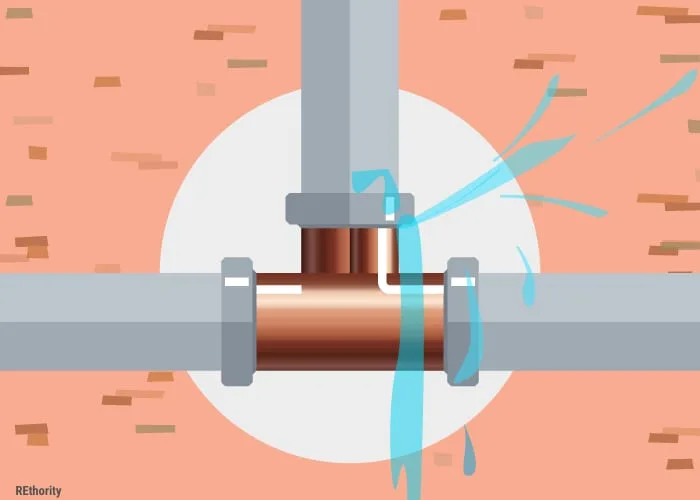
You’ll See: Leaking water running down the pipe, originating from the connectors.
Check the cold water inlet pipe and the fittings attached to it (dielectric connectors) for any leaks. Where these fittings connect to the pipe, you might notice water seeping or dripping.
If you do, try using a wrench to carefully tighten the connection. If it’s just a loose connection, tightening it should stop the leak immediately. As always, be careful not to over-tighten the connection.
This could shear the connection and require more replacement parts. If tightening connections along the pipe doesn’t stop the leak, you may have stripped or corroded connectors.
Call a plumber to inspect your water heater if this happens. They will tell you if simple parts are needed or if you’ll need to replace the entire water heater.
Rusted Anode Rod Port
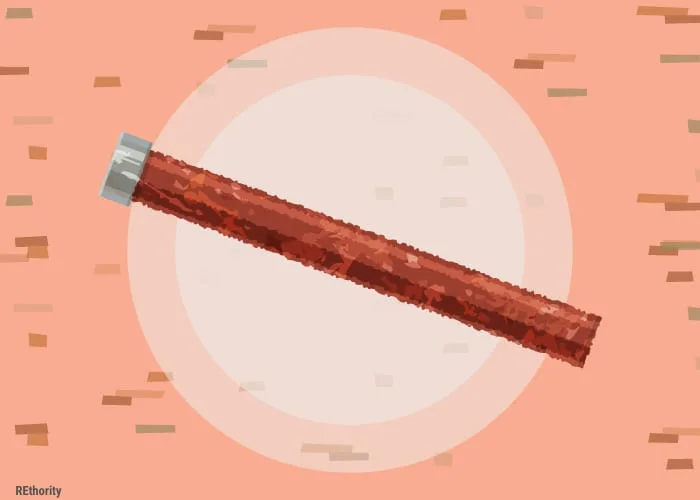
You’ll See: Water bubbling out of the anode rod port on top of the water heater.
If tightening pipe connections didn’t stop the leak, inspect the pipes around your water heater for rust. There may be rust inside that you can’t see, so calling a plumber is the best idea.
You should also inspect the steel wire you see screwed to the top of the water heater (the anode rod port). This steel wire runs the entire length of the water heater tank on the inside.
The steel anode rod port is the water heater component involved in electrolysis. It acts almost like a lightning rod. Except instead of attracting lightning, it attracts corrosion.
The water in the tank corrodes this steel wire instead of corroding the inside of the tank. The anode rod port becomes rusted and no longer facilitates electrolysis.
As a result, the corrosion reaches the top of the anode rod and forces water to bubble up and out of the rod port. This could be the source of the leak you’re seeing at the top of your water heater.
If that’s the case, the water inside the tank will start corroding and rusting the inside of the tank. You should call a plumber immediately to replace your anode rod.
Without it, there is danger of the tank corroding and rusting – even bursting – if it isn’t replaced. This can cause damage and even injury if left untreated.
Rainwater in Flue Vent
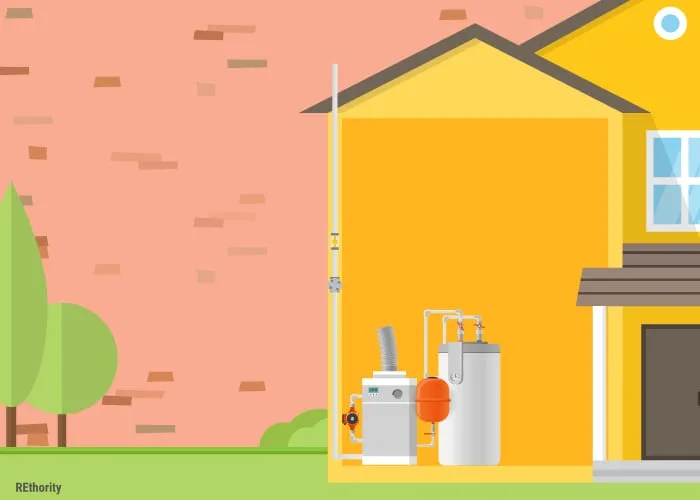
You’ll See: Leaks only during or right after rain.
If you have a gas water heater, there is a flue vent pipe that runs up through your roof. During bad storms or if parts of a flue vent pipe are damaged, rainwater makes its way into the pipe.
As a result, it appears as a leak that originates from the top of your water heater. The problem could be with the flashing, vent collar, vent cap, or the vent itself.
In any case, you may need to call a roofer to examine the flue vent to see what parts need to be replaced, repositioned, or cleared of debris.
Condensation
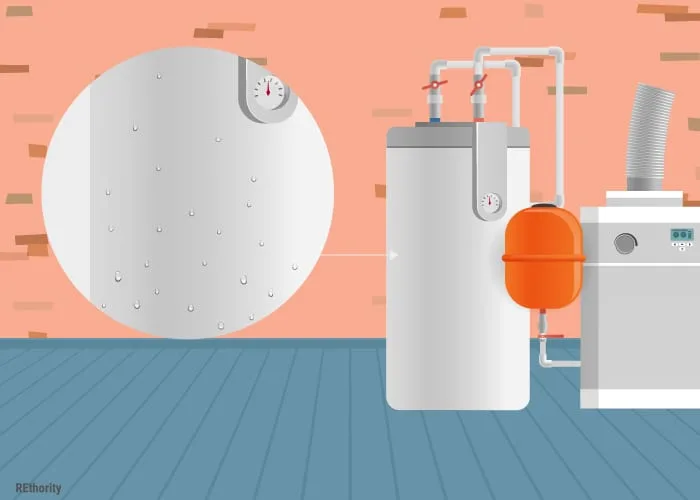
You’ll See: Drops of water collecting directly on the tank, possibly dripping down onto the floor; you may hear a sizzling sound if the water drops hit the burner.
Condensation may collect on older water heaters or those with poor insulation. Condensation occurs when there is a temperature difference between the water inside the water heater tank and the air surrounding it.
These are the most common scenarios that create condensation on a water heater:
- Older water heaters with poor insulation
- Brand new water heaters after being filled with cold water the first time
- Overworked water heaters when household hot water usage depletes all the water in the tank and causes it to refill with cold water
- Gas burning and producing water vapor in the water heater, especially high-efficiency models
If the leak turns out to be condensation, it will determine whether you should take action. If it’s a brand new water heater, having condensation upon the first tank fill is no problem.
It likely won’t continue. If you have a high-efficiency water heater, condensation is also normal. However, if you have an older water heater with poor insulation, it’s best to call a plumber.
They will be able to point you in the right direction and recommend a water heater model that is more efficient.
When to Call a Plumber
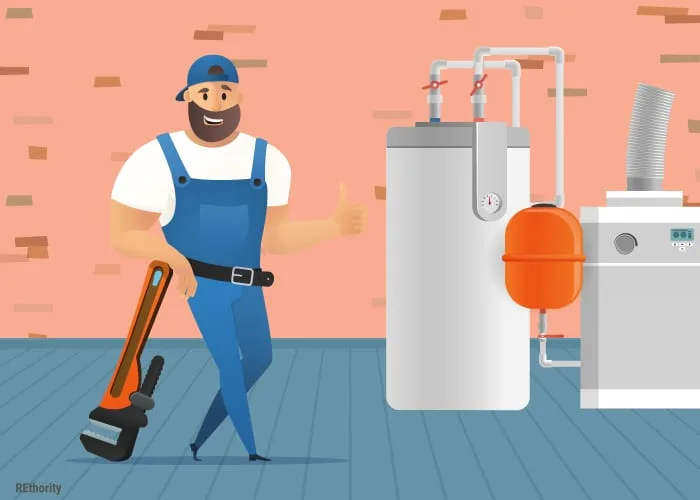
When should you call a plumber if you notice your water heater leaking from the top?
There are a few different parts and connectors you may be able to tighten on your own.
But there is always some risk involved in tampering with your home’s plumbing, especially if you’re not a professional. Even tightening a loose pipe connector can result in the connector being stripped, which will have to be replaced.
We partnered with Networx to help you find local plumbers in your area. Click to below to get a FREE quote.
How to Fix a Water heater Leaking From Top
If your water heater is leaking from the top, it’s caused by a few things (listed below).
In any case, a plumber’s expertise can ensure the leak is fixed quickly and easily and will be able to save you the cost of unnecessarily replacing the entire water heater.
- Ball valve
- TPR valve
- Expansion tank
- Pipe fittings
- Rusted anode rod port
- Flue vent
- Or just condensation
If you are still searching for a solution for your “water heater leaking from top,” you should call a plumber.
Fortunately for you, the embedded Networx form makes it easy to connect with a pro. Scroll up to do just that.
Resources:

